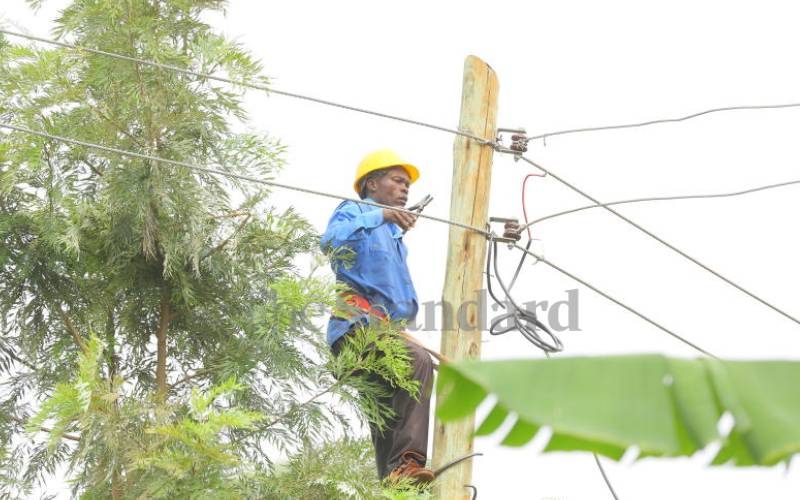
The Loiyangalani-Suswa electricity transmission line is set to cost taxpayers billions of shillings in the latest debacle over the controversial line.
This is in the wake of the collapse of four transmission towers at Longonot last December, which could prove a costly affair for taxpayers.
Other than the cost of temporary restoration achieved on January 1, the line now has to be restored permanently.
While at it, the government has to try and avoid paying penalties in case the line is unavailable to the operators of the 310MW Lake Turkana Wind Power (LTWP) plant to supply electricity to Kenya Power.
The Kenya Electricity Transmission Company (Ketraco) is set to spend more than Sh500 million to permanently restore the transmission line.
A report by the company’s management to the board in January paints different scenarios in the restoration of the line and warns that messing up the process might result in Ketraco paying LTWP penalties of up to Sh13.4 billion.
In the report, the company said the line would be permanently restored at an estimated cost of $5.525 million (Sh553 million).
It has requested the board to give it the go-ahead to recruit a new contractor to restore the transmission line permanently through a special method meant to cut the red tape in the procurement process.
“It is in the national interest that the special method of procurement is employed to fast track the procurement of a new contractor to permanently restore the Loiyangalani–Suswa line,” said the committee.
The Public Procurement and Disposal Act allows the use of procurement where “exceptional requirements make it impossible, impracticable or uneconomical” to use the open tender procurement method.
The Ketraco management noted that by using the specially permitted method, the company could get the line restored permanently in 45 days.
Using this method, there are lower risks of exposure to penalties by LTWP as it would be within the timelines allowed to have the line back up and running in case of interruptions.
This is compared to using the open tender method, which would take 387 days to get a contractor and restore the line.
This is 342 days more than the 45 days allowed in case there is an interruption on the power line after which LTWP would start levying penalties for Deemed Generated Energy (DGE).
The penalty relates to the failure by Ketraco to offer LTWP infrastructure through which it can sell electricity to Kenya Power.
Over the 342 days, Ketraco estimates that it might be required to pay a DGE penalty of Sh13.4 billion at a daily rate of Sh39 million in case the line is not available.

Major delays during the construction phase saw the government spend billions of shillings in penalties?. [Wilberforce Okwiri, Standard]
The lengthy process also presents a risk as the temporary installations currently supporting transmission lines might give in. The cost to the company will be in addition to the millions spent in December on the temporary restoration.
The line has been marred by controversy, including delays in its completion and a protracted row over its real cost.
Construction of the 428-kilometre power line started in November 2015, five years behind schedule, with its completion dates being moved several times. The Spanish contractor Grupo Isolux Corsan was forced to file for bankruptcy and the project given to a new contractor.
Ketraco came under scrutiny after it contradicted itself over the real cost of the project. The agency had said the project would cost Sh28.9 billion but later changed the figure to Sh33 billion.
Energy Cabinet Secretary Monica Juma last Thursday said the restoration works for both the Kiambere-Embakasi and Loiyangalani-Suswa lines had cost Sh246 million.
The high voltage Kiambere-Embakasi transmission line collapsed on January 11, causing a major power outage countrywide. CS Juma, however, noted that the larger cost was incurred by electricity consumers. “The effects on the economy have been colossal,” she said.
The collapse of the Loiyangalani–Suswa transmission line saw Kenya Power institute power rationing owing to shortage of supply as the LTWP plant was cut off and could not feed the grid.
The inconveniences and the costs experienced in December after the collapse of the line are still fresh but are not isolated.
Major delays during the construction phase saw the government spend billions of shillings in penalties for failure to have the line in place on time as per the agreement with the investors of the wind farm.
Ketraco terminated the contract with Isolux in 2017 and hired another firm, but it would only be able to deliver the line in September 2018.
This was one year and eight months late, which meant the government had to pay penalties to LTWP.
The government had agreed with LTWP that if the line was not completed by January 2017, it would pay monthly penalties to the company as the absence of a line meant LTWP could not monetise its investments.
“Under the agreement that was eventually entered into between LTWP, GoK and Kenya Power… LTWP required to be paid for all the electricity that is not generated if by the time it requires the transmission interconnector to evacuate at least 50MW, Ketraco had not completed construction,” reads the report by Ketraco’s management to the board.
“This energy is referred to in the PPA as the Deemed Generated Energy (DGE)… GoK also issued LTWP a letter of support in which the government undertook to pay LTWP for DGE in case the transmission infrastructure delayed because of defaults by Ketraco.”
The deemed generated energy translated to €167.26 million (Sh21.2 billion – at current exchange rates) between January 2017 when the line was supposed to have been in place and September 2018 when it was completed and could evacuate power from the wind farm to the national power grid.
“Due to delays in completing the transmission line, generated power was not evacuated from LTWP plant, resulting in accrued penalties to GoK referred to as Deemed Generated Energy (DGE) claims amounting to €167.26 million (Sh21.2 billion) from the period (between) January 27, January and September 10, 2018,” said the auditor general in a special audit report on LTWP.
Of this amount, the government, according to the auditor general, has settled Sh10.88 billion (€85.68 million). The balance is supposed to be recovered from electricity consumers through a review of LTWP’s tariff.
“Out of the accumulated DGE dues of €167.26 million (Sh21.2 billion), the government has made budgetary provisions of €85.68 million (Sh10.88 billion). This amount was budgeted under the Ministry of Energy and paid to LTWP through KPLC,” reads the auditor general’s special audit report.
“The balance of €81.58 million (Sh10.36 billion) is to be recovered by LTWP through a tariff increase by KPLC of €0.00845 (about Sh1) per kilowatt-hour (kWh).”
LTWP sells electricity to Kenya Power at a rate of €0.0722 (Sh9.2 ) per unit (kWh).
The tariff increase was supposed to have been in place between June 2018 and May 2024. It is, however, yet to be implemented. It is likely to catch up with power consumers in the coming years through higher electricity prices.
Other than the penalties that the government has had to pay, it also spent 15 per cent on the line.
According to the Special Audit Report by the Auditor General, the transmission line has been subject to controversies since it was mooted way back in 2007.
The transmission line was supposed to be developed alongside the wind farm. In this arrangement, LTWP would put up the transmission line and be paid for power that would be transmitted to the national grid using the infrastructure. This, however, did not materialise.
The report instead notes that agreements that the government signed with LTWP, the Ministry of Energy was required to construct the 428-kilometre transmission line.
It, however, appears that the ministry did not want to go through some of the processes and instead went ahead to use the contractor that LTWP had selected, which is of major concern, according to the auditor general.
“In addition (to building the wind plant), they (LTWP) were involved in part of the procurement process (invitation to tender), supposedly on behalf of Kenya Power for… the transmission line from Loiyangalani to Suswa, which was a red flag and potential conflict of interest,” said the auditor general.
When Ketraco was formed in 2008, it took over the project and in a recent report, it says it signed a contract with Isolux in 2011, relying on the background work that Kenya Power and LTWP had done. “The due diligence and negotiations undertaken in 2009 between LTWP and Isolux Ingenieria SA were undertaken with oversight provided by Kenya Power… Ketraco subsequently entered into a contract with Isolux Ingenieria SA in 2011 for the construction of the transmission line,” said Ketraco in January 2022 report.
While the 2017/2018 delays were costly for Kenya, they were not the only delays. The project was initially earmarked for completion in 2014. “The initial agreed completion date was December 31, 2013. The date was extended the first time to June 30, 2014 and extended a second time for 2.5 years to December 30, 2016,” reads the audit report by the auditor general.
“Despite this, the transmission line was not completed resulting in a further third extension. The transmission line was eventually completed on September 24, 2018 using a different contractor.”
“This raised a red flag on the capacity of the contractor initially engaged and whether due diligence was conducted prior to their selection.”
 The Standard Group Plc is a multi-media organization with investments in media platforms spanning newspaper print
operations, television, radio broadcasting, digital and online services. The Standard Group is recognized as a
leading multi-media house in Kenya with a key influence in matters of national and international interest.
The Standard Group Plc is a multi-media organization with investments in media platforms spanning newspaper print
operations, television, radio broadcasting, digital and online services. The Standard Group is recognized as a
leading multi-media house in Kenya with a key influence in matters of national and international interest.

